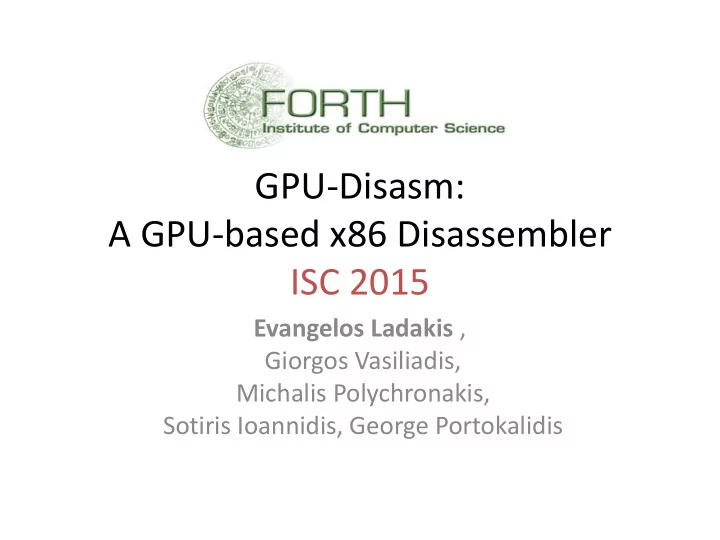

GPU-Disasm: A GPU-based x86 Disassembler ISC 2015 Evangelos Ladakis , Giorgos Vasiliadis, Michalis Polychronakis, Sotiris Ioannidis, George Portokalidis
First Impressions Evangelos Ladakis - FORTH 2
First Impressions Evangelos Ladakis - FORTH 3
First Impressions Evangelos Ladakis - FORTH 4
Outline • Background • Architecture • Optimization • Evaluation • Conclusion Evangelos Ladakis - FORTH 5
Disassembly Software Reverse Engineering • Mandatory when source code is not available o Bad guys • Find vulnerabilities • Bypass protection mechanisms o Good guys • Find malicious code • Debug and patching • Apply protection mechanisms • Techniques o Linear o Recursive Evangelos Ladakis - FORTH 6
Binary Stores • Large number of binaries • 1.6 million Google play • 1.5 million app store • Updated occasionally From a security aspect: • Analysis time and cost are essential Evangelos Ladakis - FORTH 7
Motivation • How can we build a fast and cheap Disassembler for large scale analysis? • Can we use GPU’s to accelerate the decoding process? • Why GPUs? Evangelos Ladakis - FORTH 8
General-Purpose Programming on GPUs (GPGPU) • Powerful co-processors for General Purpose Programming • Commodity hardware, relative cheap • Compute capabilities increasing • Familiar API CUDA and OpenCl Evangelos Ladakis - FORTH 9
GPU memory model Evangelos Ladakis - FORTH 10
X86-ISA • CISC architecture • 1~15 Bytes instructions Why x86? • Widely used • More challenges to address • Applying to RISC is easier Evangelos Ladakis - FORTH 11
GPU-Disasm Arch. GPU-based Disassembler of the x86 architecture Two modes: • Linear disassembly o Each thread is assigned a binary • Exhaustive disassembly o Each thread decodes one instruction of the same binary but from a different offset Evangelos Ladakis - FORTH 12
Challenges • Arbitrary accesses to Global o X86 nature • Load balancing and correctness o Utilize threads fairly with same size buffers o Start disassembling where we left • Large number of static and constant values o Fast memory interfaces are small in capacity o Store the most frequently used Evangelos Ladakis - FORTH 13
GPU-Disasm Arch. GPU-Disasm Components: How to achieve high performance: Optimize transfers Optimize the Disassembly process Pipeline the operations Evangelos Ladakis - FORTH 14
PCI Throughput • PCI 3.0 throughput evaluation Evangelos Ladakis - FORTH 15
PCI Throughput • Maximum throughput on 16MB of data Evangelos Ladakis - FORTH 16
Optimize Transfers 1. Pre-allocate page-locked I/O buffers to the host ( cudaMallocHost) 2. Place I/O to single buffers o Greater of 16 MB for PCI max throughput 3. Minimize the PCI transfer API calls Evangelos Ladakis - FORTH 17
Optimize Disassembly • Store Look-up-tables to Constant & Shared mem. • Pre-fetch input data to registers • Improve cache hits in L2 o Divide input into small buffers o Move threads as groups inside memory Evangelos Ladakis - FORTH 18
Correctness • We keep a copy of old decoded bytes and the upcomming bytes • So that we can continue decoding where we left Evangelos Ladakis - FORTH 19
Evaluation • Implementation in CUDA • System: o GPU: NVIDIA GTX 770 $396 o CPU: intel i7 $305 o Total cost $1120 • Dataset from usr of ubuntu 12.04 • Performance measured in Lines/sec Evangelos Ladakis - FORTH 20
Disassemblers Evaluation • Single threaded, discard disk I/O • Performance divergence due to output construction Evangelos Ladakis - FORTH 21
GPU-Disasm on crafted bins Buffer Size (Bytes) Average Hit Rate % (L1 to L2) 16 58.7 32 53.65 64 45.26 • Decode 2 Bytes Instructions • Impact of L2 optimization o 25.85 % more performance Evangelos Ladakis - FORTH 22
GPU-Disasm on Binaries Comparing only the disassembly process Evangelos Ladakis - FORTH 23
GPU-Disasm on Binaries Comparing only the disassembly process • Linear disassembly 2 times faster • Exhaustive average 4.4 times faster Evangelos Ladakis - FORTH 24
Pipeline Components • After 1024 batch size, disassembly becomes the bottleneck Evangelos Ladakis - FORTH 25
Hybrid (CPU & GPU) • Hybrid has 7 CPU threads and the GPU o 1 thread is needed as the GPU controller Evangelos Ladakis - FORTH 26
Power evaluation • Metrics include CPU, RAM, and peripherals power consumption o Measured internally with sensors Evangelos Ladakis - FORTH 27
Conclusion • Presented a GPU-based implementation of an x86 disassembler • 2 times faster in linear disassembly and 4.4 in exhaustive • Similar power consumption with the CPU implementation Evangelos Ladakis - FORTH 28
Thank you Evangelos Ladakis - FORTH 29
Recommend
More recommend